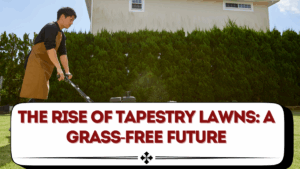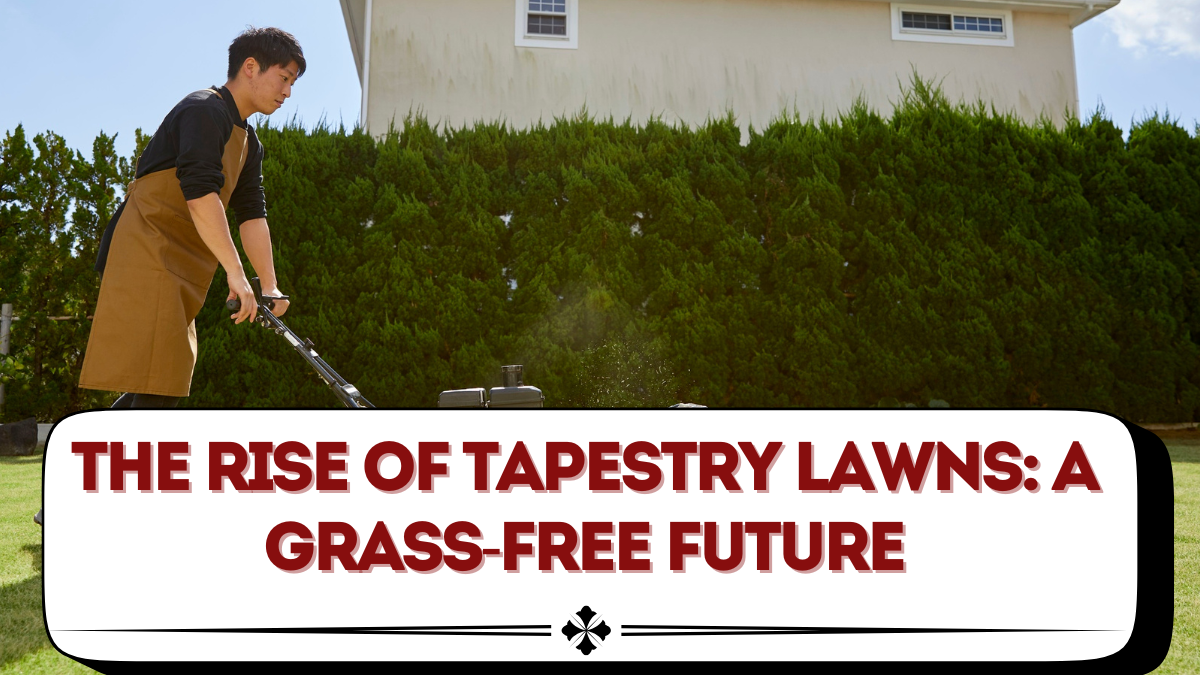For decades, the image of a perfect lawn has been associated with neatly trimmed, uniform green grass. But in recent years, homeowners and landscapers have begun questioning the sustainability and practicality of this model. Traditional lawns consume vast amounts of water, fertilizer, and mowing time, all while offering little to biodiversity. Enter tapestry lawns—a vibrant, eco-friendly, grass-free alternative that is rapidly gaining popularity across the globe.
Tapestry lawns replace conventional grass with a mix of low-growing flowering plants and ground covers. The result is a lawn that requires minimal mowing, provides seasonal color, and supports pollinators. In 2025, with rising environmental awareness and the push for sustainable landscaping, tapestry lawns are emerging as the future of gardening.

What is a Tapestry Lawn?
A tapestry lawn is a carefully designed mix of low-growing perennials and ground cover plants, chosen for their resilience, visual appeal, and ability to thrive with little maintenance. Unlike traditional turf, which is a monoculture of grass, tapestry lawns are biodiverse ecosystems.
Plants commonly used in tapestry lawns include thyme, clover, chamomile, and creeping herbs. These plants not only stay compact but also produce flowers that add texture, fragrance, and seasonal variety to the yard. The aim is to create a lawn that looks beautiful, attracts wildlife, and reduces the need for mowing and watering.
Benefits of Tapestry Lawns
The rise of tapestry lawns is not just about aesthetics—it is rooted in practical and environmental benefits.
Key benefits include:
-
Low Maintenance – Requires less mowing compared to grass lawns.
-
Water Efficiency – Many ground cover plants are drought-resistant.
-
Biodiversity Boost – Supports pollinators like bees and butterflies.
-
Seasonal Interest – Offers year-round color instead of plain green.
-
Soil Improvement – Reduces compaction and enhances soil health.
-
Pest Resistance – More resilient against lawn pests compared to monoculture grass.
By combining these advantages, tapestry lawns offer a sustainable and visually stunning alternative for eco-conscious homeowners.
Tapestry Lawns vs Traditional Grass
| Feature | Tapestry Lawn | Traditional Grass Lawn |
|---|---|---|
| Water Use | Low | High |
| Maintenance | Low (occasional trim) | High (frequent mowing) |
| Biodiversity | High | Very Low |
| Seasonal Variety | Colorful flowers and herbs | Monotone green |
| Fertilizer Needs | Minimal | Regular feeding required |
| Pest Resistance | Strong | Weak |
This comparison shows why tapestry lawns are becoming the preferred option for sustainable gardening enthusiasts.
How to Create a Tapestry Lawn
Transforming your yard into a tapestry lawn doesn’t have to be complicated.
Steps to get started include:
-
Assess Your Soil – Ensure the soil is healthy and amend with compost if needed.
-
Choose Suitable Plants – Select low-growing, drought-tolerant perennials that suit your climate.
-
Prepare the Ground – Remove existing grass or weeds and till the soil lightly.
-
Plant in Patterns – Mix different species in clusters for a patchwork effect.
-
Mulch and Water – Use mulch to retain moisture while plants establish.
-
Minimal Maintenance – Once established, only occasional mowing or trimming is required.
Designing a tapestry lawn is also an opportunity to be creative. By mixing plants with varied colors, textures, and bloom times, you can create a living mosaic that changes with the seasons.
Challenges of Tapestry Lawns
While tapestry lawns are appealing, they also come with challenges.
-
Initial Establishment – Requires careful planning and patience as plants grow.
-
Weed Management – Ground cover needs time to spread before effectively suppressing weeds.
-
Limited Play Use – Not ideal for heavy foot traffic compared to turf grass.
-
Climate Restrictions – Some plant mixes may not thrive in extreme climates without adjustments.
However, with proper planning and the right choice of plants, these challenges can be minimized.
FAQs
What plants are best for tapestry lawns?
Popular choices include thyme, clover, chamomile, creeping jenny, and other low-growing perennials suited to your climate.
Do tapestry lawns need mowing?
They require very little mowing—usually only a few times a year to maintain shape and encourage new growth.
Are tapestry lawns pet-friendly?
Yes, many ground covers are safe for pets, but it’s important to choose non-toxic species.
How long does it take to establish a tapestry lawn?
It can take one to two growing seasons for full coverage, depending on plant types and climate.
Can I convert part of my lawn into a tapestry lawn?
Absolutely, you can start small by replacing a section of grass with ground covers and expand gradually.
Conclusion
The rise of tapestry lawns signals a shift in how homeowners view their outdoor spaces. By replacing high-maintenance, water-thirsty turf with biodiverse ground cover, these lawns save resources, support pollinators, and create visually stunning landscapes. Although establishing a tapestry lawn requires planning and patience, the long-term benefits in terms of sustainability, beauty, and reduced upkeep make it a smart choice for the future. In 2025, tapestry lawns are not just a trend—they are a symbol of eco-friendly gardening and a step toward more resilient landscapes.
Click here to know more.
